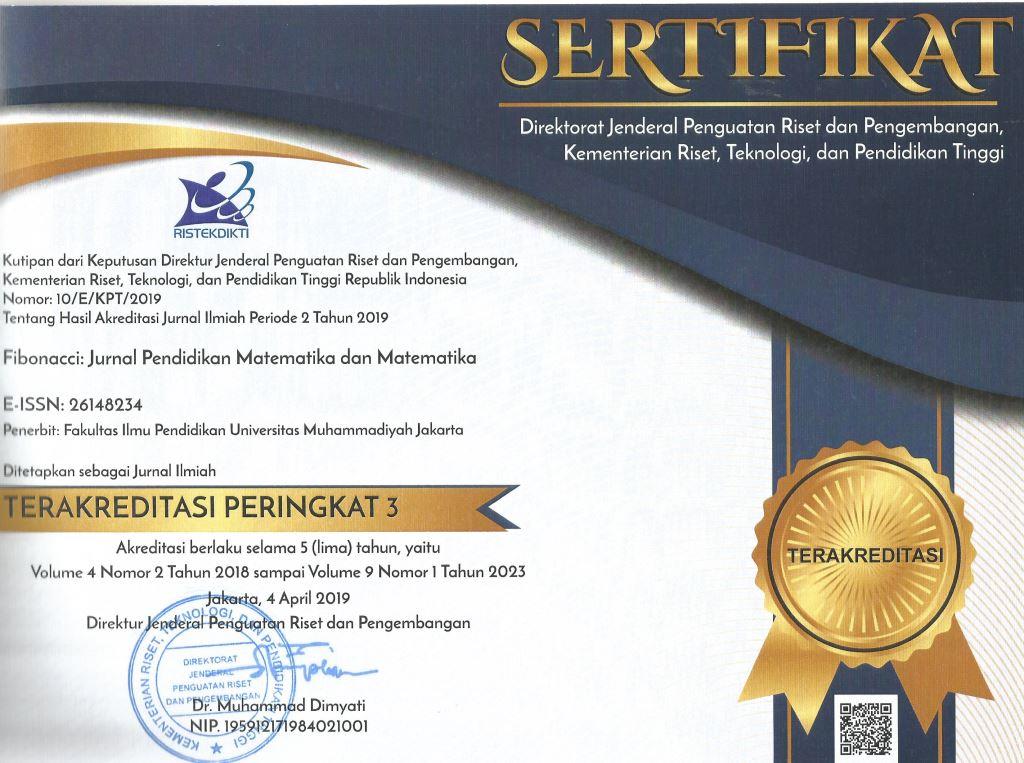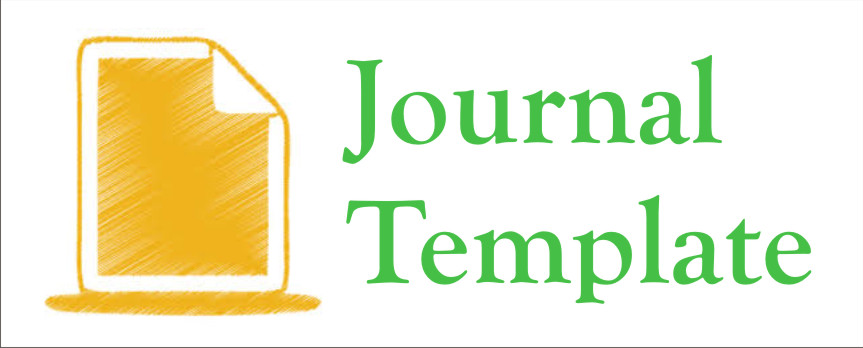EKSPLORASI KEMAMPUAN BERPIKIR KOMPUTASI SISWA SMP DALAM MENYELESAIKAN SOAL POLA BILANGAN DITINJAU DARI GAYA BELAJAR
Abstract
Kemampuan berpikir komputasi berkaitan penting pada abad ke-21 untuk membantu siswa menyelesaikan masalah matematika. Kemampuan penyelesaian masalah siswa antara lain dipengaruhi oleh gaya belajar. Tujuan penelitian ini untuk mengeksplorasi kemampuan berpikir komputasi siswa SMP ditinjau dari gaya belajar visual (V), auditori (A), dan kinestetik (K). Pendekatan penelitian ini menggunakan kualitatif dengan desain studi kasus. Subjek dalam penelitian adalah siswa kelas VIII pada salah satu SMP swasta di Sukoharjo, Jawa Tengah yang berjumlah 25 orang. Instrumen berupa soal tes materi pola bilangan, angket gaya belajar, dan wawancara untuk mengumpulan data. Sebelum digunakan, semua soal divalidasi dua orang ahli pendidikan matematika dan diujicobakan kepada 5 siswa kelas VIII. Berdasarkan hasil tes dan angket gaya belajar, dipilih 2 siswa pada setiap gaya belajar untuk diwawancarai. Hasil penelitian ini menunjukkan siswa dengan gaya belajar visual dan kinestetik mampu memenuhi semua indikator berpikir komputasi yakni abstraksi, pengenalan pola, berpikir algoritma, dan generalisasi. Sebaliknya, siswa dengan gaya belajar auditori mampu memenuhi tiga indikator berpikir komputasi yaitu abstraksi, pengenalan pola, dan berpikir algoritma. Dengan demikian, terdapat perbedaan kemampuan berpikir komputasi siswa ditinjau dari gaya belajar.
Keywords
Full Text:
PDFReferences
Agustina, S. N., Prayitno, S., & H. N. (2020). Analysis of Mathematics Problem Solving Ability Based on The Learning Style Class VIII At SMPN 13 Mataram. Indonesian Journal of STEM Education, 2(2), 58–70. https://journal.publication-center.com/index.php/ijse/article/view/204
Alfauziyya, F. M., & Masduki. (2023). Level of student’s proportional reasoning in solving algebra based on learning style. AIP Conference Proceedings, 2727. https://doi.org/10.1063/5.0141431
Angeli, C., Voogt, J., Fluck, A., Webb, M., Cox, M., Malyn-Smith, J., & Zagami, J. (2016). A K-6 computational thinking curriculum framework: Implications for teacher knowledge. Educational Technology and Society, 19(3), 47–57.
Ansori, M. (2020). Pemikiran Komputasi (Computational Thinking) dalam Pemecahan Masalah. Dirasah : Jurnal Studi Ilmu Dan Manajemen Pendidikan Islam, 3(1), 111–126. https://doi.org/10.29062/dirasah.v3i1.83
Ayu Shofa, D., Khabibah, S., & Fardah, D. K. (2023). Profile of Student’s Mathematical Connection in Aritmethic Sequences and Series Based on Learning Styles. MATHEdunesa, 10(1), 45–58. https://doi.org/10.26740/mathedunesa.v12n3.p734-754
Azizah, R., Awi, A., Asyari, S., & Siman, R. (2021). Mathematics Problem-Solving Ability Based on Learning Style of Junior High School. International Conference on Educational Studies in Mathematics (ICoESM 2021), 611(ICoESM), 27–33.
Curzon, P., Dorling, M., Ng, T., Selby, C., & Woollard, J. (2014). Developing computational thinking in the classroom: a framework. Computing at School, June, 1–6. https://eprints.soton.ac.uk/369594/1/DevelopingComputationalThinkingInTheClassroomaFramework.pdf
Danindra, L. S., & -, M. (2020). Proses Berpikir Komputasi Siswa Smp Dalam Memecahkan Masalah Pola Bilangan Ditinjau Dari Perbedaan Jenis Kelamin. MATHEdunesa, 9(1), 95–103. https://doi.org/10.26740/mathedunesa.v9n1.p95-103
DePorter, B dan Hernacki, M. (2013). Quantum Learning Membiasakan Belajar Nyaman dan Menyenangkan. Bandung: Kaifa Learning.
Edwards, M. (2011). Algorithmic composition: Computational thinking in music. Communications of the ACM, 54(7), 58–67. https://doi.org/10.1145/1965724.1965742
Firmansyah, M. A., & Syarifah, L. L. (2023). Mathematical Problem Solving Ability in View of Learning Styles. Prima: Jurnal Pendidikan Matematika, 7(1), 58. https://doi.org/10.31000/prima.v7i1.7217
Gunawan, Supriatna, Setyaningsih, E., & Fera Apriana, R. (2021). Mathematics problem solving on linear system of two variables. Journal of Physics: Conference Series, 1778(1). https://doi.org/10.1088/1742-6596/1778/1/012027
Happy, N., Setyowati, K., & Utami, R. E. (2021). Students’ Reflective Thinking Ability in Solving Mathematics Problems Assessed From Students’ Learning Style. Journal of Mathematical …, 3(1), 1–11. https://journal.unesa.ac.id/index.php/JOMP/article/view/13504%0Ahttps://journal.unesa.ac.id/index.php/JOMP/article/view/13504/7855
Ishartono, N., Faiziyah, N., Sutarni, S., Putri, A. B., Fatmasari, L. W. S.,
Sayuti, M., Rahmaniati, R., & Yunus, M. M. (2021). Visual, Auditory, and Kinesthetic Students: How They Solve PISA-Oriented Mathematics Problems? Journal of Physics: Conference Series, 1720(1). https://doi.org/10.1088/1742-6596/1720/1/012012
Ma, V. J., & Ma, X. (2014). A comparative analysis of the relationship between learning styles and mathematics performance. International Journal of STEM Education, 1(1), 1–13. https://doi.org/10.1186/2196-7822-1-3
Maharani, S., Kholid, M. N., NicoPradana, L., & Nusantara, T. (2019). Problem Solving in the Context of. Infinty: Journal of Mathematics Education, 8(2), 109–116.
Marion, Zulkardi, & Somakim. (2015). Desain Pembelajaran Pola Bilangan Menggunakan Model Jaring Laba-Laba Di Smp. Jurnal Kependidikan, 45(1), 44–61.
Murtiyasa, B., & Wulandari, S. (2022). Problem Solving Ability According to Polya on System of Linear Equations in Two Variables Based on Student Learning Styles. Jurnal Didaktik Matematika, 9(2), 261–279. https://doi.org/10.24815/jdm.v9i2.26328
Panjaitan, B. (2023). Students’ Cognitive Process to Solve Mathematics Problems Based on Learning Style. AL-ISHLAH: Jurnal Pendidikan, 15(1), 341–362. https://doi.org/10.35445/alishlah.v15i1.2788
Pusmendik Kemdikbud. (n.d.). ASESMENPEDIA. Pusmendik.Kemdikbud.Go.Id. Retrieved September 20, 2023, from https://pusmendik.kemdikbud.go.id/asesmenpedia/public-subject/basic-competence/3d072b8b-0337-47eb-81b0-40b5181ab81e
Quinn, H., Schweingruber, H., Keller, T., Framework, C., Science, N. K.-, & Standards, E. (2012). A framework for K-12 science education: Practices, crosscutting concepts, and core ideas. In A Framework for K-12 Science Education: Practices, Crosscutting Concepts, and Core Ideas. National Academies Press. https://doi.org/10.17226/13165
Rahayu, D. P., Supriyono, & Waluyo, S. B. (2017). Analysis of Mathematical Problem Solving Ability for Tenth Grader of SMK Boarding School in Terms of Learning Styles. Unnes Journal of Mathematics Education, 6(1), 10–18. https://doi.org/10.15294/ujme.v6i1.13629
Richardo, R., Mardiyana, & Saputro, D. R. S. (2014). Tingkat Kreativitas Siswa dalam Memecahkan Masalah Matematika Divergen Ditinjau dari Gaya Belajar Siswa. Jurnal Pembelajaran Matematika, 2(2), 141–151. https://doi.org/10.59141/comserva.v2i8.520
Rodríguez-Martínez, J. A., González-Calero, J. A., & Sáez-López, J. M. (2020). Computational thinking and mathematics using Scratch: an experiment with sixth-grade students. Interactive Learning Environments, 28(3), 316–327. https://doi.org/10.1080/10494820.2019.1612448
Santosa, A. D., & Khotimah, R. P. (2023). Mathematical problem solving ability from student’s learning style in material Barisan class XI science 2 senior high school 1 CEPER. AIP Conference Proceedings, 2727(1), 020028. https://doi.org/https://doi.org/10.1063/5.0141447
Sari, W. I. & Pujiastuti, H. (2020). The Influence of Students’ Learning Style Towards Students’ Mathematics Knowldge. Matematika Dan Pembelajaran, 8(1), 36–46.
Selby, C. C., & Woollard, J. (2014). Refining an Understanding of Computational Thinking. Author’s Original, 2006, 1–23.
Sulisawati, D. N., Lutfiyah, L., Murtinasari, F., & Sukma, L. (2019). Differences of Visual, Auditorial, Kinesthetic Students in Understanding Mathematics Problems. Malikussaleh Journal of Mathematics Learning (MJML), 2(2), 45–51. https://doi.org/10.29103/mjml.v2i2.1385
Sundayana, R. (2016). Kaitan antara Gaya Belajar, Kemandirian Belajar, dan Kemampuan Pemecahan Masalah Siswa SMP dalam Pelajaran Matematika. Mosharafa: Jurnal Pendidikan Matematika, 5(2), 75–84. https://doi.org/10.31980/mosharafa.v5i2.262
Syamsuadi, A. A., Aspar, A., & Syahri, A. A. (2021). Description of Mathematics Problem Solving Ability in Terms of Learning Style. MaPan, 9(2), 280. https://doi.org/10.24252/mapan.2021v9n2a6
Utami, I. D., & Masduki, M. (2023). Student’S Visual Reasoning in Solving Linear Equations in Terms of Learning Style. Prima: Jurnal Pendidikan Matematika, 7(1), 26. https://doi.org/10.31000/prima.v7i1.7171
Veronica, A. R., Siswono, T. Y. E., & Wiryanto, W. (2022). Primary School Students’ Computational Thinking in Solving Mathematics Problems Based on Learning Style. Eduma : Mathematics Education Learning and Teaching, 11(1), 84. https://doi.org/10.24235/eduma.v11i1.10378
Weintrop, D., Beheshti, E., Horn, M., Orton, K., Jona, K., Trouille, L., & Wilensky, U. (2016). Defining Computational Thinking for Mathematics and Science Classrooms. Journal of Science Education and Technology, 25(1), 127–147. https://doi.org/10.1007/s10956-015-9581-5
Wing, J. M. (2008). Computational thinking and thinking about computing. Philosophical Transactions of the Royal Society A: Mathematical, Physical and Engineering Sciences, 366(1881), 3717–3725. https://doi.org/10.1098/rsta.2008.0118
Wing, J. M. (2011). Computational thinking. 2011 IEEE Symposium on Visual Languages and Human-Centric Computing (VL/HCC), 3–3. https://doi.org/10.1109/vlhcc.2011.6070404
Zakaria, N. I., & Iksan, Z. H. (2020). Computational thinking among high school students. Universal Journal of Educational Research, 8(11 A), 9–16. https://doi.org/10.13189/ujer.2020.082102
DOI: https://doi.org/10.24853/fbc.10.1.21-38
Refbacks
- There are currently no refbacks.
Copyright (c) 2024 FIBONACCI: Jurnal Pendidikan Matematika dan Matematika
Jurnal Fibonacci Indexed By: |
 This work is licensed under a Creative Commons Attribution-NonCommercial 4.0 International License |













